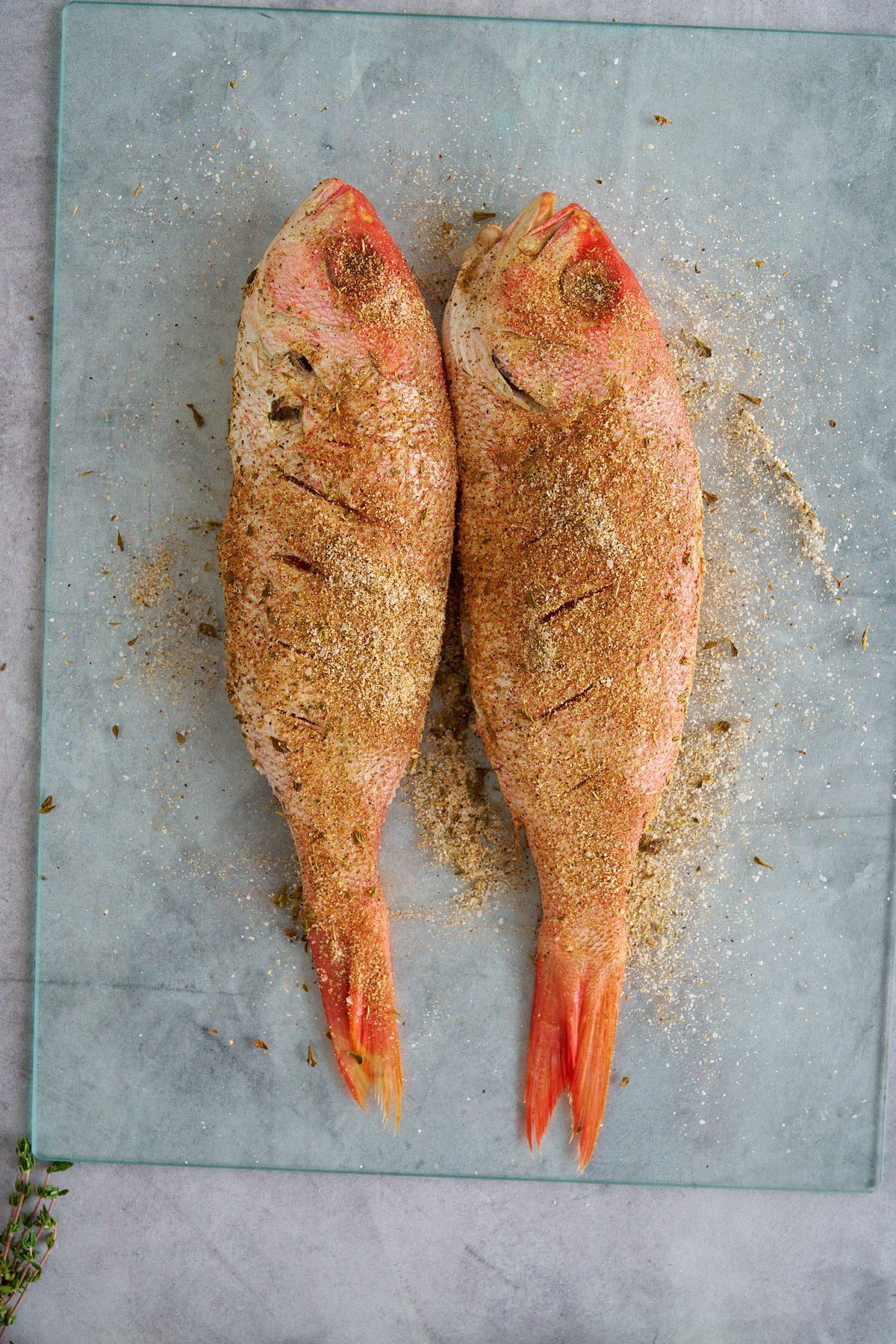This Steamed Fish Recipe is bursting with flavor and perfect for a quick and satisfying weeknight meal. Made with whole fish and paired with a medley of vibrant vegetables, it’s served with a rich, flavorful broth that takes this dish to the next level.

Full Recipe Ingredients/Instructions are available in the
recipe card at the bottom of the post.
You can find important tips/tricks in the
blog post.
Fish has always been a staple in my home, appearing on our dinner table at least twice a week. Growing up near the beach, my Dad would bring home fresh fish regularly—a tradition I didn’t fully appreciate as a child but cherish deeply now.
This Jamaican-inspired steamed fish is a nod to my parents’ cooking but with a few of my personal touches. I use my homemade fish seasoning to season the fish and vegetables before steaming them with some vegetable broth. The fish becomes tender, and the dish is full of flavor.
You'll notice that I don't use a steamer or bamboo basket to steam the fish. For this method, the fish is steamed in a sauté pan using the vegetables as a base and vegetable broth as the steaming liquid.
Do you love fish as much as I do? Check out my Oven-Baked Fish recipe or my Jamaican Escovitch Fish for other easy and tasty options.
The Ingredients I Use for this Recipe
Ingredient amounts and full recipe instructions are on the printable recipe card at the bottom of the post.
For the Fish
- 2 whole snapper fish (1.5-2 pounds), cleaned and scored for even cooking. You can also use other kinds of fish, like tilapia, sea bass, cod, or grouper. These options work well for steaming because they have firm, flaky flesh that absorbs flavors beautifully without falling apart during cooking.
- Fish seasoning: Adds robust flavor to the fish. You can use store-bought or homemade.
- Lime juice: Essential for cleaning the fish.
The Vegetables and Aromatics
- Vegetables: Onions, tomatoes, carrots, bell peppers, and okra create a vibrant, healthy base.
- Garlic and scallions: Add depth to the dish with their aromatic flavors.
- Fresh thyme and scotch bonnet pepper: Bring authentic Jamaican flavors, with the pepper adding optional heat. If you can't find a scotch bonnet, habanero and jalapeño are good substitutes.
Steaming Liquid
- Vegetable stock: Serves as the flavorful base for steaming.
- Butter: Adds richness to the broth. You can use unsalted or salted.

Tools Needed
- Sauté Pan with Lid: Ideal for steaming fish and vegetables evenly, thanks to its tall sides and wide base. You can also use a large skillet if you don't have a sauté pan.
- Sharp Knife: Perfect for scoring the fish and prepping vegetables.
- Cutting Board: A sturdy surface for slicing and chopping ingredients.
- Fish Spatula or Tongs: To handle the fish gently without breaking it apart.
- Wooden Spoon or Silicone Spatula: To stir vegetables without damaging the pan.
How to make Steamed Fish
1. Steamed fish prep
Clean the fish thoroughly with lime juice and water, then pat dry. Score the fish by cutting shallow diagonal cuts on both sides of the fish.
Season the fish (inside and out) with fish seasoning. Let it marinate for 20 minutes to soak in the flavors.

2. Set Up the Vegetables for Steaming
Heat olive oil in a large skillet over medium heat.
Add the sliced onions, carrots, bell pepper, garlic, green onions, and scotch bonnet pepper to the skillet. Sauté for about 1-2 minutes to release their flavors. Add the remaining fish seasoning to the vegetables and stir.
Pour in the vegetable stock and bring the mixture to a boil. Add the tomatoes, okra, thyme, and butter.

3. Steam the Fish
Place the seasoned fish on top of the vegetable mixture. Spoon some of the hot liquid over the fish to keep it moist.
Cover the skillet tightly and steam over medium-low heat for 15-20 minutes (for whole fish) or 10-12 minutes (for fillets).

4. Serve and Enjoy
The fish is done when it flakes easily with a fork and the vegetables are tender. Serve the fish by spooning the broth and vegetables over the top.
Remove the skillet from the heat and serve.
Hint: Spoon some of the rich broth and softened vegetables over the fish for a beautiful presentation.

Make-Ahead and Storage Options
While this dish is best served fresh to maintain the tender texture of the fish and the vibrancy of the vegetables, you can prepare some components ahead of time to save time:
Clean and Season the Fish:
Clean the fish with lime juice and water, pat it dry, and season it up to 24 hours in advance. Store the seasoned fish in an airtight container in the refrigerator.
Prep the Vegetables:
Slice and chop the vegetables (onions, carrots, tomatoes, bell peppers, etc.) ahead of time. Store them in separate airtight containers or zip-top bags in the refrigerator for up to 2 days.
Storage Instructions
Refrigerate: Cool fish to room temperature, store in an airtight container, and refrigerate for 3-4 days.
Reheat: Warm fish and broth in a skillet over medium-low heat to maintain texture.
Freeze (Not Ideal): If needed, freeze in a sealed container for up to 1 month. Thaw in the fridge and reheat gently.

The Best Fish for Steaming: Top Picks for Flavor and Texture
When it comes to steaming, choosing the right fish is key to getting tender, flaky, and flavorful results. Whole snapper is a top choice for its firm texture and ability to hold up during cooking, making it perfect for dishes like Jamaican steamed fish. Other great options include tilapia, sea bass, and cod—all mild, versatile, and ideal for absorbing the delicious flavors of your steaming liquid and seasonings.
For the best results, opt for fresh, high-quality fish, and don’t forget to clean and score it for even cooking!
Sides to Complete Your Steamed Fish Meal
Serve your steamed fish with some classic sides to round out the meal. Rice and peas make the perfect hearty base, while callaloo adds a boost of greens. And don’t forget the green banana and boiled dumplings—they’re just right for soaking up all that flavorful broth!
Tanya's Top Tip
To keep your vegetables vibrant and delicious, add delicate ones like okra and tomatoes later in the cooking process. This prevents them from becoming too soft or mushy, ensuring they retain their texture and flavor while complementing the tender steamed fish.
I hope you like this Jamaican steamed fish recipe as much as we do!
Looking for other recipes like this? Try these:
If you have tried this or any other recipe on my blog, please rate it and let me know how it turned out in the comments below!
Jamaican Steamed Fish Recipe
Ingredients
- 2 whole snapper fish 1.5-2 pounds, cleaned and scored
- 1 lime juiced (for cleaning and seasoning the fish)
- 2 Tablespoons fish seasoning separated
- 2 Tablespoons olive oil
- 1 medium yellow onion sliced
- 1 carrot thinly sliced
- 1 bell pepper sliced
- 2 green onions (scallions) chopped
- 4 cloves garlic minced
- 2 slices scotch bonnet pepper optional, for heat
- 1 Roma tomato chopped
- 6-8 whole okra pods trimmed
- 1 cup vegetable stock
- 4 sprigs fresh thyme
- 2 Tablespoons unsalted butter
Instructions
- Clean the fish with lime juice and water, then pat dry.
- Season the fish (inside and out) with 1.5 Tablespoons fish seasoning. Let it marinate for 20 minutes.
- Heat olive oil in a large skillet over medium heat. Add the sliced onions, carrots, bell pepper, green onion, garlic, and scotch bonnet pepper to the skillet. Sauté for about 1-2 minutes to release their flavors. Add the remaining fish seasoning to the vegetables and stir.
- Pour in the vegetable stock and bring the mixture to a boil. Add the tomatoes, okra, thyme, and butter to the pan.
- Place the seasoned fish on top of the vegetable mixture. Spoon some of the hot liquid over the fish to keep it moist.
- Cover the pot tightly and steam over medium-low heat for 15-20 minutes.
- The fish should flake easily with a fork and appear opaque, and the vegetables should be soft and tender.
- Remove the skillet from the heat.
- Serve with rice and peas, steamed callaloo, or boiled dumplings. Spoon some of the broth and softened vegetables over the fish.
Notes
- You can replace whole fish with fish filets. For fish filets, reduce cooking time to 10-12 minutes for fillets.
- Large fish will take longer to steam. Ensure the fish flakes easily with a fork.










Sundy says
What is in your fish seasoning? Recipe looks great!
Tanya says
Thanks Sundy. My fish seasoning recipe, https://www.myforkinglife.com/homemade-fish-seasoning/, has ingredients like salt, garlic and onion powder, oregano, black pepper, paprika, thyme, and allspice
Helen LaRose says
When do you add the fish to the pan? I'm sure it doesn't cook while marinating.
Tanya says
Hi Helen, you are correct. The fish is added after you add the broth and vegetables. You lay it on top.